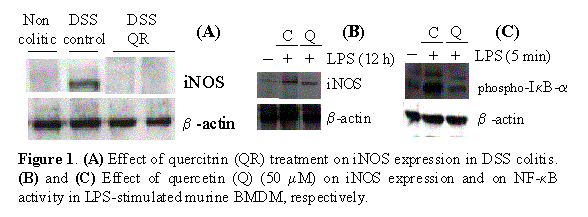| pA2 online © Copyright 2004 The British Pharmacological Society |
151P
GKT, University of London Winter Meeting December 2003 |
|
The intestinal
antiinflammatory effect of quercitrin is associated with an inhibition
in inos expression via downregulation of NK-
|
|
Quercitrin, 3-rhamnosylquercetin,
is a flavonoid that exerts antiinflammatory activity in experimental colitis
(Sanchez de Medina et al., 1996). The present study investigates the mechanisms
involved in this effect. Colitis was induced in female Wistar rats (170-190
g) by incorporating dextran sulfate sodium (DSS) in drinking water at
5% (w/v) during 5 days and at 2% (w/v) for the following 10 days. One
group of animals (n=10) was treated orally with quercitrin (1 mg/kg/day)
dissolved in distilled water (4 ml/kg), starting when DSS concentration
was changed. A DSS control group (n=10) and a non-colitic group (n=10)
were also included for reference. All animals were sacrificed 15 days
after. The colonic inflammatory status was evaluated microscopically,
on a 0 to 30 scale, (Stucchi et al., 2000), and biochemically: total glutathione
content, NOS activity (Rodriguez-Cabezas et al., 2002) and NF-![]() B
activity (Renard et al., 2001). Colonic iNOS expression was also evaluated
by immunoblotting. in vitro experiments were also performed in primary
cultures of murine bone marrow derived macrophages (BMDM) (Comalada et al., 2003) stimulated with LPS (100 ng/ml) to study the effects of quercitrin
and quercetin on iNOS expression and NF-
B
activity (Renard et al., 2001). Colonic iNOS expression was also evaluated
by immunoblotting. in vitro experiments were also performed in primary
cultures of murine bone marrow derived macrophages (BMDM) (Comalada et al., 2003) stimulated with LPS (100 ng/ml) to study the effects of quercitrin
and quercetin on iNOS expression and NF-![]() B
activation by Western blot. Data were expressed as mean ± S.E.M.
Differences among means were tested for statistical significance using
one-way analysis of variance (ANOVA) and post hoc least significance tests.
B
activation by Western blot. Data were expressed as mean ± S.E.M.
Differences among means were tested for statistical significance using
one-way analysis of variance (ANOVA) and post hoc least significance tests.
analysis of the specimens
revealed that the flavonoid reduced the histological score from 12.4 ±
2.8 in the control group to 5.7 ± 1.9 (p<0.05). Quercitrin counteracted
colonic glutathione depletion (1762 ± 67 vs. 1517 ± 49 nmol/g
tissue in control group; p<0.01), and inhibited colonic NOS activity
(74.4 ± 7.0 vs. 97.8 ± 6.1 pmol citrulline/mg protein in
controls; p<0.05). An inhibition in colonic iNOS expression was also
observed (Figure 1A). In addition, a significant reduction in colonic
activated NF-![]() B levels
was obtained after quercitrin treatment (57554 ± 7650 vs. 85158
± 4429 arbitrary units in control group; p<0.05). in vitro experiments
revealed that quercetin (50 mM), but not quercitrin, inhibited both iNOS
expression (Figure 1B) and NF-
B levels
was obtained after quercitrin treatment (57554 ± 7650 vs. 85158
± 4429 arbitrary units in control group; p<0.05). in vitro experiments
revealed that quercetin (50 mM), but not quercitrin, inhibited both iNOS
expression (Figure 1B) and NF-![]() B
activation (Figure 1C) in LPS-stimulated BMDM.
B
activation (Figure 1C) in LPS-stimulated BMDM.

In conclusion, the
intestinal antiinflammatory effect of quercitrin was associated with an
improvement on intestinal oxidative stress and with downregulation of
colonic NOS activity via inhibition of NF-![]() B
signalling pathway.
B
signalling pathway.
Comalada M et al. (2003) J Immunol 170: 4450-6.
Renard P et al. (2001) Nucleic Acids Res 29: e21.
Rodriguez-Cabezas et al. (2002) J Nutr 132: 3263-71.
Sanchez de Medina F et al. (1996) J Pharm Exp Ther 278:771-9.
Stucchi AF et al. (2000) Am J Physiol 279: G1298-306.